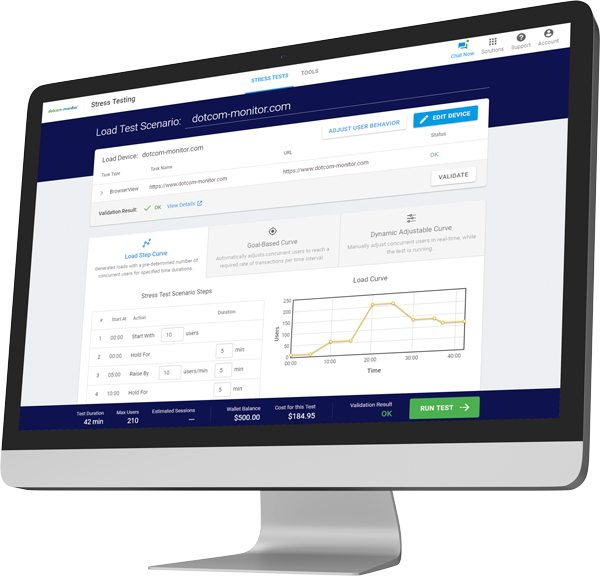The world of load testing platforms can be daunting if you’re just starting out. It’s a growing market filled with a diverse array of quality tools to pick from. At a certain point, you’re faced with a question: “Do I pay up front for a load testing tool? Or do I go for a free tool and save my money?” The answer may seem obvious. Why pay for something you can get online for free? The truth is that there are tradeoffs to any decision and “free” tool may end up being more costly than the alternative.
Both free and paid load testing can be appropriate choices depending on what it is you’re looking for. Those who may go for a free option may be the ones who could benefit from the features of a paid option the most. We’ll walk you through the pros and cons of free and paid load testing tools, and ultimately help you make the right decision.
What to Look For in Load Testing Tools
Developers know just how vital load testing tools are and are constantly trying to improve upon the technology we already have. There are countless options for different needs, so the answer for what makes a good tool varies person to person and project to project.
If you’re new to the load testing game, here are a few things you want to look for in a load testing tool beyond merely the price:
1. How easy is it to use?
This will always be the number one priority. Your skill set will determine if you should look for a more user friendly tool that requires less effort to figure out. A longer learning curve could mean more time devoted to testing and less time to have your site, application, or API up and running.
2. How realistic is the simulation?
A wide variety of simulations, load curves, and load injectors are available to developers. The most popular type of simulation is headless testing. LoadView allows you to take advantage of real browser testing, which can provide a simulation that reflects real users behavior.
3. How much support do you get?
This could either refer to tech support directly from the platform, giving you help from experts 24/7 and one on one guidance, or how robust the platform’s community is. Platforms like JMeter have message boards, forums, and no shortage of online tutorials, but it takes time and effort to sort through all of that content.
With these questions in mind, you can start to explore your options.
Pros & Cons of Free Load Testing Tools
The first clear benefit of free load testing tools is of course price. Free load testing may not always be ideal, but it’s better than no testing at all if you have no budget for load testing. If you’re a smaller business looking to cut down on expenses the free price can be a huge selling point. While it is tempting to say this is always the best choice, the truth is that the benefits you receive from a free tool may be worth the cost.
The money spent on a paid tool goes towards paying developers to create an interface that is much easier to navigate. If you’re tech savvy, this is no issue. You can read up on load testing forums and fix the problem yourself, but if you’re newer to web development this can present roadblocks. You’ll have to devote more time and energy into learning how to use your chosen platform.
Because these tools were developed and maintained for free, they also lack the breadth of simulation options a paid option like LoadView provides. Remember real browser testing? This one of just a few unique features LoadView provides that can be well worth the cost up front and down the road.
If you’re still curious about free platforms, don’t worry. There are many free load testing tools that are great options that provide you with high quality simulations. Here are a few of the most popular open source load testing tools:
JMeter
JMeter is by far the most popular, free open source load testing platform. It stacks up pretty close to most commercial tools, but misses a few key features. If you’re looking to carry out larger scale tests, using real browsers, and taking advantage of LoadView’s ability to generate virtual users from multiple locations, JMeter might not be the tool for you.
Gatling
Gatling is another free open source load testing tool written in Java. It can provide similar results to JMeter, and is more developer focused, great for those who already are familiar with JavaScript and load testing tools.
Gatling is a more user friendly tool that is able to run basic tests. If you’re looking for scale, Gatling may be lower on your list of choices.
Locust
Locust is yet another open source load testing tool. Locust allows you to run some of the largest concurrent user loads of any open source tool. The main drawback of Locust is that it is written in Python, making it inaccessible to anyone that doesn’t already have knowledge of multiple script languages.
Paid Options for Load Testing
These are all possible options for developing your website through load testing, though they may not be ideal for carrying out all the different types of necessary tests to get your website, application or API functioning as smoothly as possible. Though the above tools are free up front, they could cost you money down the road through inadequate test results and failure to properly test at scale.
The other option is to use a paid load testing platform like ours at LoadView. LoadView is a feature-rich SaaS tool that features real browser testing, so there’s little to no learning curve and no extra equipment or skills needed. With LoadView you get what you paid for, a clean, simple, user friendly experience so you can focus on getting your website up and running.
Using LoadView to Load Test Your Website
LoadView a SaaS-based service, so there’s little to no learning curve and zero extra equipment or skills needed. With LoadView you get what you paid for, a clean, simple, user friendly experience so you can focus on getting your website up and running. Unlike most open source platforms LoadView is anything but complicated. Its full automated platform means all you have to do is create an account and get started.
LoadView has many unique features that set it apart from the competition. Including:
- Real browser testing
- Multiple load curves
- Easy to use interface
- 24/7 technical support
- Ability to generate load from multiple geographic locations
- Cloud-based load injectors
The tools we provide at LoadView are essential to secure long term success for your site, application, or API. Simulating diverse and unpredictable situations with professional load testing will help you prepare for the unexpected and give you confidence in your website’s functionality whatever comes its way. The amount of time, effort, and stress you’ll save using LoadView is more than worth it.
If you’re interested in saving energy, get a free trial of LoadView, and learn more about what makes LoadView an excellent load testing platform that’s worth the investment every time.

